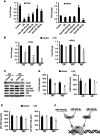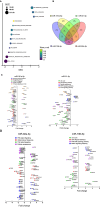Identification of Senomorphic miRNAs in Embryonic Progenitor and Adult Stem Cell-Derived Extracellular Vesicles
- PMID: 40275616
- PMCID: PMC12266766
- DOI: 10.1111/acel.70071
Identification of Senomorphic miRNAs in Embryonic Progenitor and Adult Stem Cell-Derived Extracellular Vesicles
Abstract
Extracellular vesicles (EVs) are secreted by most cell types, transmitting crucial signaling molecules like proteins, small RNAs, and DNA. We previously demonstrated that EVs from murine and human mesenchymal stem cells (MSCs) functioned as senomorphics to suppress markers of senescence and the inflammatory senescence-associated secretory phenotype (SASP) in cell culture and in aged mice. Here we demonstrate that EVs from additional types of human adult stem cells and embryonic progenitor cells have a senomorphic activity. Based on their miRNA profiles showing prevalence in stem cell EVs versus nonstem cell EVs and the number of age-related genes targeted, we identified eight miRNAs as potential senomorphic miRNAs. Analysis of these miRNAs by transfection into etoposide-induced senescent IMR90 human fibroblasts revealed that each of the miRNAs alone regulated specific senescence and SASP markers, but none had complete senomorphic activity. Evaluation of ~300 combinations of miRNAs for senotherapeutic activity identified a senomorphic cocktail of miR-181a-5p, miR-92a-3p, miR-21-5p, and miR-186-5p that markedly reduced the expression of p16INK4a, p21Cip1, IL-1β, and IL-6 and the percentage of SA-ß-gal-positive cells. Transcriptome analysis identified multiple pathways affected by the miRNA cocktail, including cellular senescence and inhibition of PCAF and HIPK2 in the p53 signaling pathway. Finally, treatment of aged mice with liposomes containing the four miRNA cocktail suppressed markers of senescence and inflammation in multiple tissues. These studies suggest that EVs derived from stem cells suppress senescence and inflammation, at least in part, through miRNAs and that a senomorphic miRNA cocktail could be used to target senescence and inflammation to extend health span.
Keywords: aging; antiaging; cellular senescence; molecular biology of aging; senescence.
© 2025 The Author(s). Aging Cell published by Anatomical Society and John Wiley & Sons Ltd.
Conflict of interest statement
J.L. and D.L. are employees of AgeX, G.C. is a co‐founder of Unicyte GmbH, and S.K.L. is a co‐founder of Paracrine Therapeutics. L.J.N. and P.D.R. are co‐founders of Itasca Therapeutics and inventors on several senescence‐related patents owned by the University of Minnesota.
Figures






References
-
- Anisimov, V. N. , Berstein L. M., Egormin P. A., et al. 2008. “Metformin Slows Down Aging and Extends Life Span of Female SHR Mice.” Cell Cycle 7, no. 17: 2769–2773. - PubMed
-
- Ben Halima, S. , Siegel G., and Rajendran L.. 2016. “miR‐186 in Alzheimer's Disease: A Big Hope for a Small RNA?” Journal of Neurochemistry 137, no. 3: 308–311. - PubMed
-
- Bi, Y. , Qiao X., Cai Z., et al. 2025. “Exosomal miR‐302b Rejuvenates Aging Mice by Reversing the Proliferative Arrest of Senescent Cells.” Cell Metabolism 37: 527–541.e6. - PubMed
-
- Chen, C. , Zhou M., Ge Y., and Wang X.. 2020. “SIRT1 and Aging Related Signaling Pathways.” Mechanisms of Ageing and Development 187: 111215. - PubMed
MeSH terms
Substances
Grants and funding
LinkOut - more resources
Full Text Sources
Research Materials
Miscellaneous

